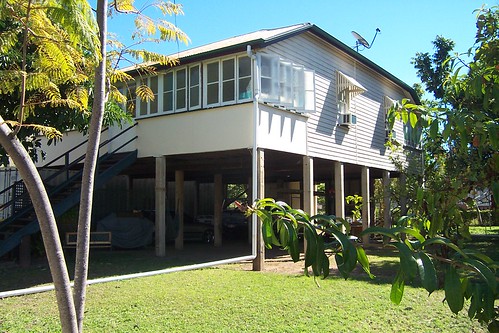However today I see that someone else has mentioned it publicly so at least I'm not out on my own here.
You see, I feel that the floods are no worse than what we've had in the past, and certainly nothing unexpected in terms of a 100 year event. However because we've been building in places we previously didn't and building places unsuited to the location we've now copped lot of damage.
I've been looking at the "flooding" here on the Gold Coast and felt that most of it was in areas which older locals would never have built in and in styles we didn't traditionally build in. Strangely its only recently (at the end of some decades of drought) that these areas have been "re-zoned" to be available for development.
Caution has taken a back seat to greed and the desire to move a population here.
I had been doing a little research on this and had come across an PhD by Allison Godber who identified that people buying into property
"do not understand the risks of flooding represented by the standards formally adopted by local government and as a result misinterpret their levels of flood risk exposure"
in lay speak this means people build in areas which may wipe them out when (not if) it floods.
She is not the only one suggesting this, as today I also found this:
Central Queensland University researcher John Rolfe said Emerald's decisive moment came in the early 1990s when the council made the decision to release land for subdivision along the flats beside the Nogoa River rather than on the high land near the airport to the east of the river.
"When you look at the aerial pictures from the floods, you'll see that Old Emerald is largely untouched; it's the new areas which have gone underwater" Rolfe said
"Back in the 1990s when mining was really taking off, most of the planning decisions were made at that stage to release the land along the river.
Its sort of funny, but quite tragic in reality that we fail to heed the opinions of those who have experience in the area and instead favor what ever advice fits with doing what we want to.
Queensland is one of the fastest growing states, which means we are getting thousands of people with no experience of the region move in and settle every month. This can only mean people without a clue about what its like here.
If you look around you see all the older houses look rather like this:

unless they're built in areas which are on tops of hills ... but even then they are often still on shorter posts.
The reason for this should be clear to people now, but just in case it isn't here is why:

So while it may be annoying to have a meter of water under your house...
 Its much better than having a meter of water through your house.
Its much better than having a meter of water through your house.Even in the devastating 1974 floods heaps of people were spared having their houses and property ruined by simply building according to the conditions.
I'm at a loss why we seem to forget this, but I can only put it down to people being ignorant, developers being too greedy, and fashion dictating how we build our homes.
I've been reading how cockamamie ideas are circulating about now "flood proofing" Queensland.
For gods sake, when will we learn that for every action there is a reaction, we can't "tame nature" and we do well to learn to live within its means.
Many towns are build around farming and many farming areas are built around fertile soil and water. Unsurprisingly these are often in areas called "flood plains" (just in case you don't remember your Grade 10 geography classes). For these ecosystems (and ones modified into productive farmlands) soil fertility is benefited by flooding. Rather like this:

Our grandparents seemed to understand this and work with it, so perhaps its time to get a little sence back into our system again??











2 comments:
And you don't have to be a scientist to notice this. Have often said, as we drive past new suburbs on old flood plains, "you couldn't MAKE me live there!" Maybe it helps to have some long term memory left.
Too right!
Why can't the "Queenslander" be the normal construction style up there, rather than the McMansion!
Post a Comment